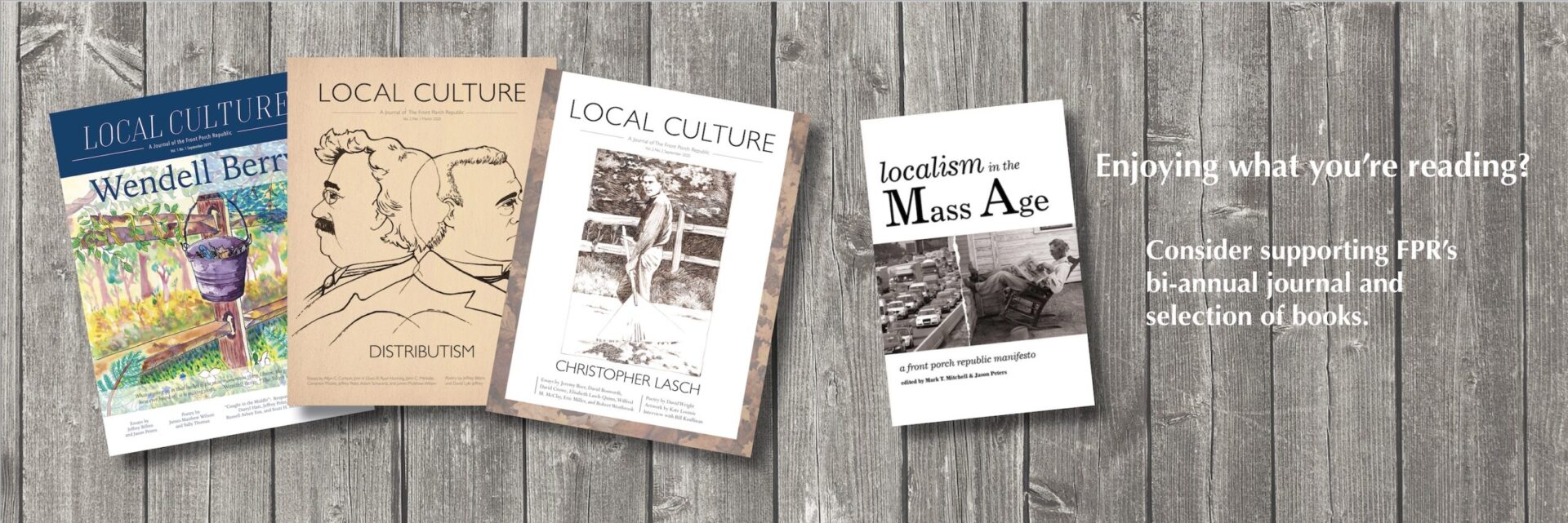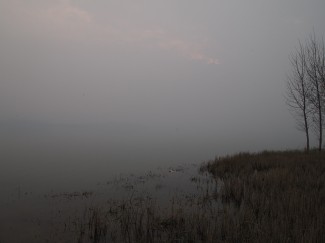It began with a subtle lifting of wings from treetops. A moving dark mirage in the sky, growing in strength as I stare. In the not-yet moments before the full sunrise, when red streaks are saturating the eastern sky, the largest murmuration of starlings I have ever seen is rising above and alongside my car, filling the view in my front windshield. Vast loveliness surrounds me.
From my home in east central Missouri, I am travelling this Saturday morning to meet my sister at the University of Illinois and hear from author, actor, woodworker (and Wendell Berry admirer) Nick Offerman. The Mississippi River is the first mental and physical barrier I must cross. To a farm woman frightened of city traffic, the highways east of the river are a deterrent to any trips to Illinois and eastward without good cause. Immediately after the river, “All Lanes” signs promise to lead to a diaspora that includes Memphis, Chicago, Indianapolis, and Louisville. It may as well say Timbuktu and the Solomon Islands, for all the sense it makes to me.
An audiobook of The Natural History of Selbourne by Gilbert White is my companion on the drive. Gilbert White’s detailed observations of his environment remind me of my late father, who lived his entire life in one section of farmland in the plat book, the fourth generation in his family to do so. Because of farming longevity in a small geographic area, and a family tradition of oral storytelling, my father possessed a century’s worth of cumulative knowledge of the land and its features, the weather, the type of soil and trees and birds, and many other minute details. He related intricate accounts of what trees grew in which hollows, and why, and how a drought or a particular strong wind from the west in the previous century had affected them. As a girl, all these stories were a pleasant and sometimes boring backdrop to our lives. Only when I grew older did I ask him to repeat those stories to me, and sadly, I have retained only a small portion of his intimate knowledge of the farm where I now live and work.
Soon enough, I am funneled onto Interstate 55 heading north, leaving the confusing concrete jungle behind me. Signs indicate the Cahokia Mounds, the largest pre-Columbian site north of Mexico that was a cultural and economic powerhouse around 1000 A.D. It is now a UNESCO World Heritage Site. I make a mental note to bring my grandchildren here soon. Forests line the highway on either side, the bare trunks at this hour revealing no hint of the rising sap and swelling buds of early March. Today, these awakening trees are the roosting spot for tens of thousands of starlings, poised and ready to alight at the first harbinger of day.
I am about to be treated to one of nature’s rare displays.
“Murmuration” is a word not in common usage. As a noun, it refers to a large flock of starlings. Starlings are the only birds known to form murmurations. They glide and wheel near each other, forming fluid shapes in the sky. No one who has seen one will forget the sight. One of the amazing aspects of a murmuration is that despite the shifting movements, starlings do not collide with each other. Starlings have an innate ability to react to the birds closest to them, through careful observation of their closest neighbors in the flock. Murmurations do not have a single leader. The individual starlings, when acting as a group, transcend individual intention and become a breathing, living entity.
Scientists are not sure why starlings form murmurations, which occur in the spring and fall during migratory seasons. Many experts believe they form for safety in numbers, especially from predatory birds. They also may provide heat to each other. Do birds feel a need for community? No one knows, but it is hard not to look at a murmuration and feel the connection and freedom that come from being part of a cohesive flock so attuned to each other that they can glide and morph peacefully.
Watching this display, I am in a bedazzled trance. I maintain my speed on the highway, aware of the danger of slowing down or pulling over. The murmuration is endless, it seems. It goes on for over a mile, with fringed edges like wings to the side as the sight recedes to my rearview mirror.
Was I holding my breath the whole time? It feels like it, as I inhale deeply, filling my lungs with the frosty morning air.
As Gilbert White continues his exploration of Selborne and I make my way to the university, I reflect on my good fortune to see a murmuration. I wonder if Gilbert White wrote about any, or how many my father had seen, and when and where they were. Were they as affected by the sight as I had been? They would make a better record of it for later re-telling than I was likely to do–a by-product of living in a digitally distracting age with decreasing attention spans.
My sister and I are attending a fund-raising luncheon to hear from Nick Offerman. As an admirer of Wendell Berry, Nick is supportive of small family farms like mine. Last year, he sponsored a scholarship that enabled me to attend a grazing school. I am attending this event to thank him in person for his kindness. Fancy events are a rarity for me. I prefer to be in the company of plain and ordinary people. In certain settings, I sense the attendees’ eventual obituaries will be crammed full of amazing career achievements (not like those matter to the grandkids), outstanding roles they played in their local communities, leadership awards they won, and important people they knew. Such obituaries do not impress me. My natural prejudice is that fancy events are filled with people who may have fancy obituaries someday.
Nick Offerman’s words at the luncheon covered many topics, some of them not mentionable in polite company. Something he said, though, struck a chord considering the murmuration I had witnessed early that morning.
He talked about the importance of doing good deeds. Small, good deeds, like greeting someone. Making something with your hands. Being peaceable. Using your talent and making good choices. Avoiding things that bring harm to yourself or others. Showing up when you say you will. All these things combined, he said, could change the world if more people did them. They might reduce war. And make everyone happier.
I looked around at the luncheon audience, each person listening as intently as me. I no longer saw fancy people, just good people.
An epiphany sprouted in my heart. Can good deeds become like murmurations? This question troubled my conscience on the four-hour drive home.
Each good deed in isolation has its own merit. As a recipient of a good deed, I am blessed, but the person who performed the good deed is blessed also. But what if people were like starlings in being aware of how to respond to those closest to them? What if we did not require a leader to direct us in doing good deeds, but could join with a host of other people in doing small, everyday things? What if these good deeds were not worthy of mention in our obituary, but were commonplace courtesies and kindness? And like starlings, what if no one person sought recognition but acted in cohesion with like-minded people, locally and, rippling out through our communities, around the globe? I considered how Nick’s generosity in sponsoring me at a grazing school had multiplied. Because of it, I had met other like-minded farmers, have become more skilled with my animal husbandry, and now, inexplicably, had attended a fund-raiser at a Japanese House in Illinois and met a new group of good people. If one small deed multiplies like this, how much more so when they become a widespread practice.
I have seen good deeds become murmurations. Consider the response to natural disasters, such as floods or hurricanes. The next day, unpaid relief groups of ordinary people are on their way there, with food trucks, construction tools, drinking water and more. They come from near and far, from churches or civic groups or motorcycle clubs. Good deeds transcend social or economic class.
Small local murmurations are common. Consider a family whose child has cancer. The community holds fundraisers, people bring meals over or offer rides or housecleaning. The oft-practiced Amish values of neighborliness and community show themselves after a barn or house fire. Neighbors are there within hours to start cleaning up, and within a week, a new structure is in place. The hidden, ordinary people who step up when needed, without recognition, are the starlings in the flock. Always responding to those around them, staying in constant communication, seeking warmth in a storm and protection from danger.
All of this occurs without economic calculation. Instead, it is a social transaction that demands no repayment. The economists are confounded by widespread, off-the-books kindness.
Bad deeds can also become murmurations. Rising tides of prejudice toward groups, mostly people who think or look or believe differently than us, can foster a culture of discrimination that can even lead to wars. Fascism spread across Europe in the 1930s in a seemingly unstoppable dark cloud. Economic piracy, thinly disguised in marketing wasteful and overpriced consumer goods to those who will soon be dissatisfied and need to buy more, is a murmuration that is out of control. As a farmer, I see a society where most consumers have little knowledge of where their food is from, how it was raised or how it affected the people who worked to bring it to the grocery store shelves. This is surely a dangerous murmuration.
If murmurations of good deeds can become strong and persist, they may in time dispel harmful murmurations.
The attention to detail that Gilbert White and my father had for their small piece of the world aided them in being able to care for it. Once they had the knowledge, they were bound to have respect. If we notice others around us and gain knowledge of what individual people are like, it will be harder to disrespect them and easier to be kind.
The lessons of murmuration are clear. There is power and safety in community. We must pay close attention to those around us. No one is more important than another, but each one has value. Small choices often have a multiplicative impact. We will stay warm if we are together.
Image via: Flickr












